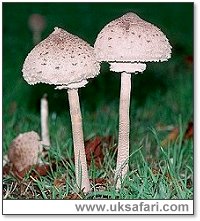
|

|
|
 Sent
to you Sent
to you
by e-mail
|
|
Simply
enter your details and hit the send button
more
info |
|


Click Here

Links
Advertise
Terms of Use
Contributors
About Us
Contact Us
|
 |
Go back
 | Bookmark
| Bookmark
 | Print Page
| Print Page  | E-Mail Us
| E-Mail Us 


 Photo: G. Bradley
Photo: G. Bradley
|
|
UK
Safari Tip:
To help you identify fungi there's a superbly illustrated fold out chart
in the Nature Shop - click here
|
|
Latin name: Macrolepiota procera
Size: Caps can have a diameter of up to 30cms.
Distribution: Found throughout the UK.
Months seen: July to November.
Habitat: Often found in meadows and at woodland edges.
Special features: They are conical in shape when young, but as they mature they become almost flat. The caps are a creamy colour with brownish scales, and the gills are also creamy white.
The parasol mushroom cap is quite tasty if cooked, but can be poisonous if eaten raw. There are similar looking mushrooms that are not edible. The way to tell them apart is to move the ring, underneath the cap, up and down the stem. If it moves freely it's a parasol. It it's attached to the stem, it's another variety which could be poisonous.
Did You Know?
The seeds of fungi are called spores. One mushroom cap measuring 10cms. across can produce 16,000,000,000 spores (sixteen billion).

UK Safari Fungi Section
|
 |

|